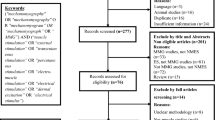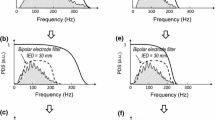Abstract
An attempt at utilizing mechanomyography (MMG) to quantify muscle fatigue, which occurs on account of repeated functional electrical stimulations (FES), is presented. Twenty-one subjects participated in the experiment, wherein a constant electrical stimulation was repeatedly applied to the tibialis anterior muscle. MMG signals were measured simultaneously, as the stimulations were applied, and subsequently quantified using 8 different methods. Muscle fatigue was confirmed by observing linearly decreasing ankle-joint torque with the repetition of the electrical stimulation (r2 = 0.7823). The convex-hull area and volume along with peak-to-peak MMG signals were found to demonstrate significant linear relationships with muscle fatigue in spite of the weakness in motion artifacts. Use of the Lempel-Ziv algorithm, based on three symbols, provided the most accurate correlations for muscle fatigue. However, frequency-based characteristics as well as mean and median frequencies did not demonstrate any significant linearity with muscle fatigue.
Similar content being viewed by others

References
Giat, Y., Mizrahi, J., and Levy, M., “A Musculotendon Model of the Fatigue Profiles of Paralyzed Quadriceps Muscle under FES,” IEEE Transactions on Biomedical Engineering, Vol. 40, No. (7), pp. 664–674, 1993.
Liberson, W., “Functional Electrotherapy: Stimulation of the Peroneal Nerve Synchronized with the Swing Phase of the Gait of Hemiplegic Patients,” Archives of Physical Medicine and Rehabilitation, Vol. 42, pp. 101–105, 1961.
Lee, J., “Functional Electrical Stimulation (FES): Part 1,” Physical Therapy Korea, Vol. 2, No. (1), pp. 62–70, 1995.
Bélanger, M., Stein, R. B., Wheeler, G. D., Gordon, T., and Leduc, B., “Electrical Stimulation: Can it Increase Muscle Strength and Reverse Osteopenia in Spinal Cord Injured Individuals?” Archives of Physical Medicine and Rehabilitation, Vol. 81, No. (8), pp. 1090–1098, 2000.
Wang, J., Chen, S., Lan, C., Wong, M., and Lai, J., “Neuromuscular Electric Stimulation Enhances Endothelial Vascular Control and Hemodynamic Function in Paretic Upper Extremities of Patients with Stroke 1,” Archives of Physical Medicine and Rehabilitation, Vol. 85, No. (7), pp. 1112–1116, 2004.
Glaser, J. A., Baltz, M. A., Nietert, P. J., and Bensen, C. V., “Electrical Muscle Stimulation as an Adjunct to Exercise Therapy in the Treatment of Nonacute Low Back Pain: A Randomized Trial,” The Journal of Pain, Vol. 2, No. (5), pp. 295–300, 2001.
McBain, R. A., Boswell–Ruys, C. L., Lee, B. B., Gandevia, S. C., and Butler, J. E., “Abdominal Muscle Training Can Enhance Cough after Spinal Cord Injury,” Neurorehabilitation and Neural Repair, Vol. 27, No. (9), pp. 834–843, 2013.
Yamanishi, T., Sakakibara, R., Uchiyama, T., Suda, S., Hattori, T., et al., “Comparative Study of the Effects of Magnetic Versus Electrical Stimulation on Inhibition of Detrusor Overactivity,” Urology, Vol. 56, No. (5), pp. 777–781, 2000.
Yin, J. and Chen, J. D., “Mechanisms and Potential Applications of Intestinal Electrical Stimulation,” Digestive Diseases and Sciences, Vol. 55, No. (5), pp. 1208–1220, 2010.
Levy, M., Mizrahi, J., and Susak, Z., “Recruitment, Force and Fatigue Characteristics of Quadriceps Muscles of Paraplegics Isometrically Activated by Surface Functional Electrical Stimulation,” Journal of Biomedical Engineering, Vol. 12, No. (2), pp. 150–156, 1990.
Kurosawa, K., Futami, R., Watanabe, T., and Hoshimiya, N., “Joint Angle Control by FES Using a Feedback Error Learning Controller,” IEEE Transactions on Neural Systems and Rehabilitation Engineering, Vol. 13, No. (3), pp. 359–371, 2005.
Kim, C., Kazunori, H., Kang, G., and Eom, G., E., “Control of FES Cycling Considering Muscle Fatigue,” Journal of the Korean Society of Precision Engineering, Vol. 22, No. (6), pp. 207–212, 2005.
Zhang, Q., Hayashibe, M., Fraisse, P., and Guiraud, D., “FES–Induced Torque Prediction with Evoked EMG Sensing for Muscle Fatigue Tracking,” IEEE/ASME Transactions on Mechatronics, Vol. 16, No. (5), pp. 816–826, 2011.
Deley, G., Denuziller, J., Babault, N., and Taylor, J. A., “Effects of Electrical Stimulation Pattern on Quadriceps Isometric Force and Fatigue in Individuals with Spinal Cord Injury,” Muscle and Nerve, Vol. 52, No. (2), pp. 260–264, 2015.
Winter, D. A., Fuglevand, A. J., and Archer, S. E., “Crosstalk in Surface Electromyography: Theoretical and Practical Estimates,” Journal of Electromyography and Kinesiology, Vol. 4, No. (1), pp. 15–26, 1994.
Winslow, J., Jacobs, P. L., and Tepavac, D., “Fatigue Compensation during FES using Surface EMG,” Journal of Electromyography and Kinesiology, Vol. 13, No. (6), pp. 555–568, 2003.
Chesler, N. C. and Durfee, W. K., “Surface EMG as a Fatigue Indicator during FES–Induced Isometric Muscle Contractions,” Journal of Electromyography and Kinesiology, Vol. 7, No. (1), pp. 27–38, 1997.
Kim, G.-W. and Kim, J., “Analysis of Surface EMG Power Spectrum and Muscle Fatigue Depending on the Variable of Neuromuscular Electrical Stimulation,” The Journal of Korean Physical Therapy, Vol. 26, No. (5), pp. 280–289, 2014.
Yochum, M., Binczak, S., Bakir, T., Jacquir, S., and Lepers, R., “A Mixed FES/EMG System for Real Time Analysis of Muscular Fatigue,” Proc. of Annual International Conference of the IEEE Engineering in Medicine and Biology, pp. 4882–4885, 2010.
Allen, D., Lannergren, J., and Westerblad, H., “Muscle Cell Function during Prolonged Activity: Cellular Mechanisms of Fatigue,” Experimental Physiology, Vol. 80, No. (4), pp. 497–527, 1995.
Cè, E., Rampichini, S., Limonta, E., and Esposito, F., “Torque and Mechanomyogram Correlations during Muscle Relaxation: Effects of Fatigue and Time–Course of Recovery,” Journal of Electromyography and Kinesiology, Vol. 23, No. (6), pp. 1295–1303, 2013.
Ma, M., “MMG Sensor for Muscle Activity Detection: Low Cost Design, Implementation and Experimentation,” M.Sc. Thesis, Massey University, 2010.
Beck, T. W., Housh, T. J., Johnson, G. O., Weir, J. P., Cramer, J. T., et al., “Mechanomyographic Amplitude and Mean Power Frequency Versus Torque Relationships during Isokinetic and Isometric Muscle Actions of the Biceps Brachii,” Journal of Electromyography and Kinesiology, Vol. 14, No. (5), pp. 555–564, 2004.
Krueger, E., Scheeren, E. M., Nogueira–Neto, G. N., and Nohama, P., “Mechanomyography Energy Decreases during Muscular Fatigue in Paraplegicsm,” Proc. of the 36th Annual International Conference of the IEEE in Engineering in Medicine and Biology Society, pp. 5824–5827, 2014.
Shin, I., Ahn, S., Choi, E., Ryu, J., Park, S., Son, J., and Kim, Y., “Fatigue Analysis of the Quadriceps Femoris Muscle Based on Mechanomyography,” International Journal of Precision Engineering and Manufacturing, Vol. 17, No. (4), pp. 473–478, 2016.
Posatskiy, A. O. and Chau, T., “The Effects of Motion Artifact on Mechanomyography: A Comparative Study of Microphones and Accelerometers,” Journal of Electromyography and Kinesiology, Vol. 22, No. (2), pp. 320–324, 2012.
Talebinejad, M., Chan, A. D., and Miri, A., “A Lempel–Ziv Complexity Measure for Muscle Fatigue Estimation,” Journal of Electromyography and Kinesiology, Vol. 21, No. (2), pp. 236–241, 2011.
Frigo, C., Ferrarin, M., Frasson, W., Pavan, E., and Thorsen, R., “EMG Signals Detection and Processing for On–Line Control of Functional Electrical Stimulation,” Journal of Electromyography and Kinesiology, Vol. 10, No. (5), pp. 351–360, 2000.
Muraoka, Y., “Development of an EMG Recording Device from Stimulation Electrodes for Functional Electrical Stimulation,” Frontiers of Medical and Biological Engineering, Vol. 11, No. (4), pp. 323–333, 2001.
Orizio, C. and Gobbo, M., “Mechanomyography,” Wiley Encyclopedia of Biomedical Engineering, 2006.
Jaskólska, A., Brzenczek, W., Kisiel–Sajewicz, K., Kawczyński, A., Marusiak, J., and Jaskólski, A., “The Effect of Skinfold on Frequency of Human Muscle Mechanomyogram,” Journal of Electromyography and Kinesiology, Vol. 14, No. (2), pp. 217–225, 2004.
Krueger, E., Scheeren, E. M., Nogueira–Neto, G. N., Button, V. L. S. N., and Nohama, P., “Correlation between Spectral and Temporal Mechanomyography Features during Functional Electrical Stimulation,” Research on Biomedical Engineering, Vol. 32, No. (1), pp. 85–91, 2016.
Tarata, M. T., “Mechanomyography Versus Electromyography, in Monitoring the Muscular Fatigue,” Biomedical Engineering Online, Vol. 2, No. 1, Paper No. 3, 2003.
Barry, D. T. and Cole, N. M., “Muscle Sounds are Emitted at the Resonant Frequencies of Skeletal Muscle,” IEEE Transactions on Biomedical Engineering, Vol. 37, No. (5), pp. 525–531, 1990.
Mohamad, N. Z., Hamzaid, N. A., Davis, G. M., Abdul Wahab, A. K., and Hasnan, N., “Mechanomyography and Torque during FESEvoked Muscle Contractions to Fatigue in Individuals with Spinal Cord Injury,” Sensors, Vol. 17, No. 7, Paper No. 1627, 2017.
Author information
Authors and Affiliations
Corresponding author
Rights and permissions
About this article
Cite this article
Jo, M., Ahn, S., Kim, J. et al. Mechanomyography for the Measurement of Muscle Fatigue Caused by Repeated Functional Electrical Stimulation. Int. J. Precis. Eng. Manuf. 19, 1405–1410 (2018). https://doi.org/10.1007/s12541-018-0166-0
Received:
Revised:
Accepted:
Published:
Issue Date:
DOI: https://doi.org/10.1007/s12541-018-0166-0



